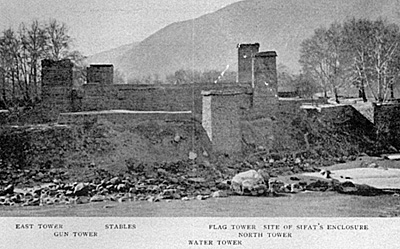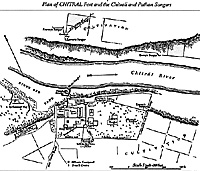"Each night there were alarms, when the Garrison still wanting experience, responded with unnecessary commotion and much sounding of bugles."
--Major Robertson
 CHITRAL Fort: Showing the Marble Rock, the Water Tower Tunnel, and the remains of Campbell's Covered Way
CHITRAL Fort: Showing the Marble Rock, the Water Tower Tunnel, and the remains of Campbell's Covered Way
FORCES ENGAGED
BRITISH
Commander - Major Robertson
Lt. - Gurdon
Capt. - Campbell,Townshend, Harley, Baird
Capt. - Whitchurch (surgeon).
Native Officers approx. - 8
Kashmir rifles (Sepoys) - 260 ind. some Gurkhas
14th Sikhs - 83
TOTAL - 356 men approx.
543 total people within fort.
Total made up by clerks, servants and Puniali levies.
There were 54 Chitralis within the fort incl. the young Mehtar and some followers.
CHITRALIS/PATHAN BESIEGER
Commander(s) Sher-Afzul and two Khans acting for Umra Khan. Approx. 1,500 - Pathans - many well armed with Martini and Snider rifles (1,000 arrived on the 5th March all followers of Umra Khan.) Approx. 1,000 Chitralis - not as well equipped, many armed with older Jezail and Matchlock rifles. Generally supporters of Sher-Afzul. TOTAL - 2,500 at start of siege.
THE FORT
Major Robertson explains the construction and layout.
"The Chitral fort, and its attached buildings, are on the verge of the river bank, so scarped away at that particular place as to be practically inaccessible, except at one narrow gully where a rough rocky path, of surprising steepness, has been partly converted into a tunnel by the isolated water tower which encloses and roofs it in, and is then carried, in two floors, above the plane of the stable enclosure, but not quite so high as the north-east parapet. According to the seasonal meltings in the mountain-born river, the distance between the lower end of the tunnel and the water's edge is lengthened or contracted. During the early months Of the year it is at its greatest. Over this intervening space, as already mentioned, Campbell, previous to our beleaguerment, constructed an invaluable passage more than five feet high. On account of the inequalities of the ground its direction was as irregular as its floor was uneven.
"Several great boulders, including the marble rock half in and half out of the water, were utilised in marking the walls, and gave them strength. From lack of time and material no roofing had at first been attempted. One night the enemy ran up a crafty work, showing no loop holes, on the opposite bank, whence their marksmen found the short range so helpful, that out of the five men wounded during the first week, four were shot in this passage.
By the marble rock and at the foot of the tower were the dangerous spots. Wood for properly
closing in the narrow way was now obtained by the demolition of the storerooms and other apartments just outside of the main gate, under one of which poor Baird's body lay buried. This head cover was hastily and clumsily made, but fulfilled its object.
Large Fort plan (slow: 99K)
"From the fort side of the water - tower there is a steep but short climb to the narrow level space separating the stables from the parapeted wall. The last two of three feet of this sharp ascent always remained exposed, but a couple of quick steps to the left gained good shelter. Water-carriers, however could not be persuaded of the risk in pausing for breath just at the top of the slop.
"Fatalistically, or fatuously, they invariably
rested a moment at this dangerous edge, and it was
not until two of the poor fellows were shot dead
within a short interval that the remainder could be
induced to halt two yards short of the top, take
breath, and then scramble up the last few feet and
dodge smartly to the left for the protection of the
stable wall. By this method, they gave not time for
that deliberate shooting which the Chitralis
marksman, properly parsimonious of ammunition,
loves so well.
"Campbell's waterway constituted the rigid
south boundary of a bay of white sand, which is
covered in the melting season. Its curving northern
limit, the only accessible place, was the
comparatively low bank of a marshy flat covered
with big trees. This flat, held by the enemy, was
considerably lower than the level of the fort, which
it reached by a steep path debouching in front of
the main gate. Between path and gate an oblong
enclosure intervened, thanks to Sifat Bahadur,
who, by his demolitions, had converted a mass of
buildings and passages into that simple form. Ae
sand itself, being the open way for a direct assault
upon the loopholed waterway, had to be sedulously
protected, and one ofthe chiefproblems of the
defence was how to converge from walls, parapet,
and towers, such a fire upon it as would crush the
masterful charge of a furious foe.
'And now, a word about the structure of the
fort. The walls are made of coarsly-squared
timbers, some 4 inches by 4 inches, laid
horizontally between the layers of stones embedded
in mud mortar. In thickness the walls vary, being
especially strong near the main entrance, which is
on the west side, and feeblest on the flank looking
down the valley to the south. The long timbers are
strengthened in position by short cross pieces,
similarly made of inflammable pine wood, which
stick out some few inches from the wall like stumpy
almonds from the surface of a plum pudding. at the
corners of the tower, where the long lateral timbers
overlap, they are often fixed together by a clumsy
tenon and mortise and jut forth several inches
beyond the uneven walls.
"Projecting knobs are, therefore, to be
found all over the foil, but particularly close
together upon the towers. A monkey would find
them convenient steps to climb anywhere, while a
little Chitralis could follow him in most places.
"The immense amount of wood in the towers,
where the intervening layers of masonry are only a
few inches thick, is not all disclosed to the view. For
there is an inner pine wood frame corresponding to
that seen form without, and separated from it by
about a foot of rubble. In very dry weather it would
be almost sufficient to light one of these
structures with a torch to make it blaze like a blast
furnace.
'A transverse block of buildings divides the
foil into two unequal oblongs, that on the river side
being the larger. this part is used by the public
generally, and it is provided on three sides with a
maze of living roomsfor the garrison, servants and
guests. One room of great size, with a ood
verandah, was the old durbar hall. We uselit as
hospital. Many of the rooms have a central smoke-
hole large enough for the passage of a man, as
poor Gurdon found one night when going his
rounds to visit the sentries on the banquette. Hefell
through one of these apertures on the floor below,
happily with no worse damage than bruises and a
bad shake.
"On the other or south side of the great
partition is the private half of the fort and the
women's quarters. None but a very select few of
their subjects ever visited the Mehtars of Chitral in
that dignified and secluded place. It has one large
and three smaller courtyards, the rest being
covered in; and it was on its flat, continuous roofs
that promenades were possible at night when the
firing was slack. While there was light all business
there had to be transacted at a trot. it was
interesting to watch the different modes of hurrying
across this exposed place in the daytime. Most did
so at the double, as above described. One or two
walked with prodigiously long rapid steps, which
took them faster than another man's run, and with a
nervous grin, almost amounting to a frozen smile, in
the direction whence a shot might be expected. A
very few ambled along, gurgling with
facetiousness, and making occasional jumps over
imaginary bullets. These were the wags among the
native servants."
Ammunition
300 rounds per man for the Sikhs Martini
Henry rifles.
280 rounds per man for the Sepoys Snider
rifles.
2 old 7-pd cannons with 80 rounds of
ammunition - solid shot.
Capt. Harley started to prepare DIY forms of
bullet from the large supply of gun powder
available. He luckily possessed a book on the
subject.
Food
Eough for 3 months.
1 lb of flour per day for each man. There were
some tins of beef and some condiments as well as
some pea flour.
The Officer's had some rice and at least 2
geese, with some sheep kept for the wounded.
There were several ponies within the fort which
could be used as food in an emergency. Some rum
was available, one dram was issued every 4 days,
religion permitting.
More Chirtral: The Siege
Siege: The Fort
 Plan of CHITRAL Fort and the Chitrali and Pathan Sangars
Plan of CHITRAL Fort and the Chitrali and Pathan Sangars
Jumbo Fort plan (slow: 147K)
SUPPLY SITUATION
Siege: Day-by-Day Diary
Siege: The Attack
Siege: Battle Profile, Analysis, and Wargaming the Battle
Siege: Chitral Expedition Illustration: Malakand Pass (Large 65K)
Siege: Chitral Expedition Illustration: Malakand Pass (Jumbo very slow: 358K)
Siege: Wargame Photos (Large: very slow: 225K)
Back to Colonial Conquest Issue 3 Table of Contents
Back to Colonial Conquest List of Issues
Back to MagWeb Master List of Magazines
© Copyright 1993 by Partizan Press.
This article appears in MagWeb (Magazine Web) on the Internet World Wide Web.
Other military history articles and gaming articles are available at http://www.magweb.com